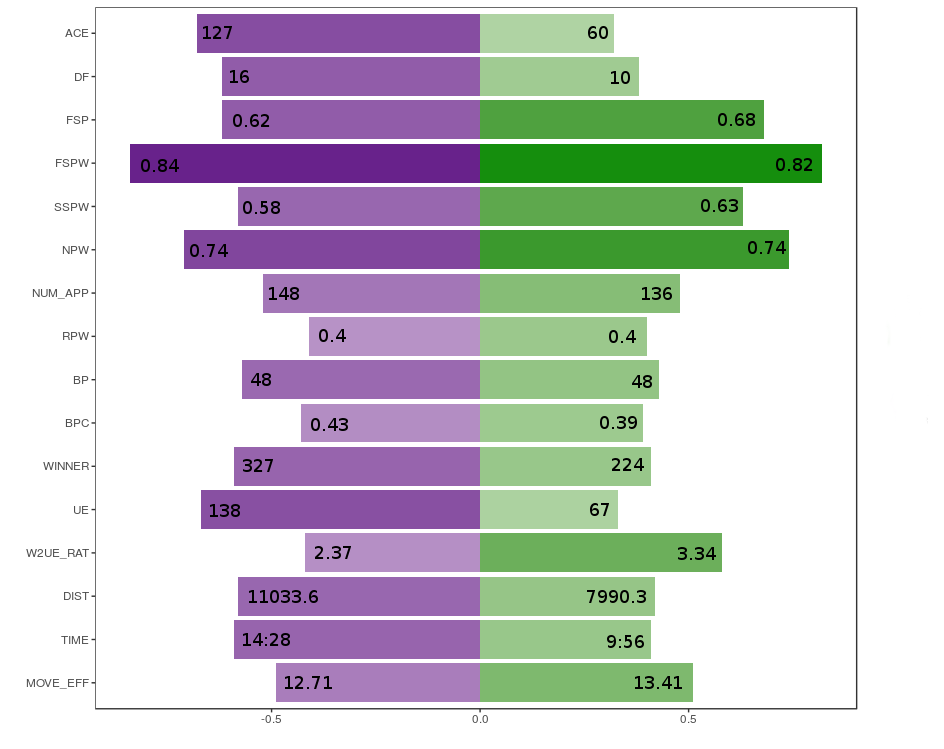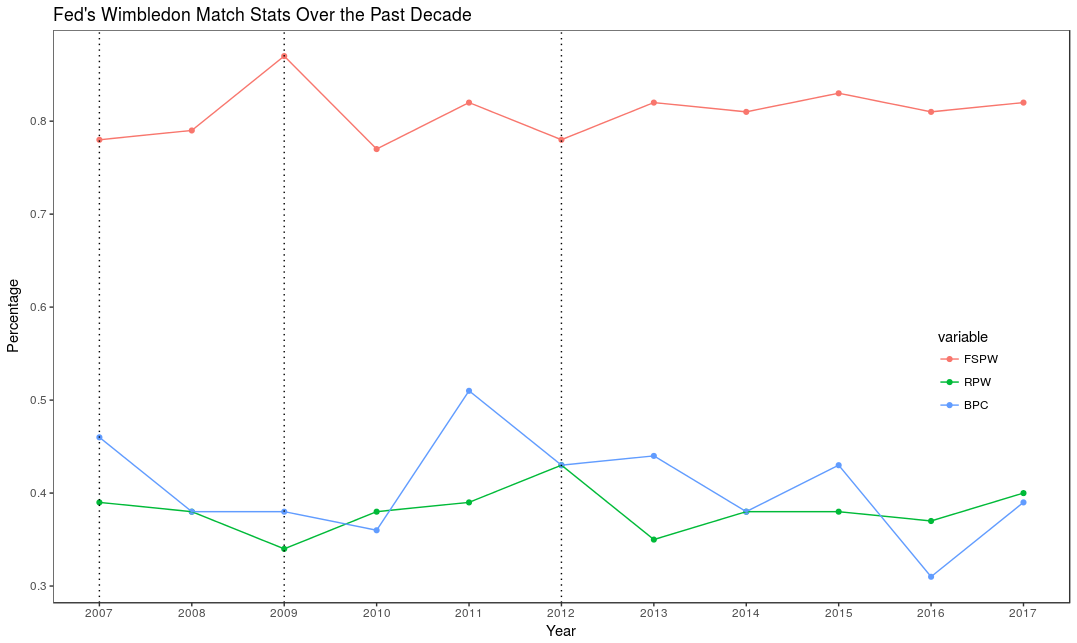Wimbledon 2017 Championship Preview
Published:
Overview
On Sunday afternoon, Roger Federer will meet Marin Cilic in the Wimbledon Finals, with Federer looking to win his 8th Wimbledon title. His opponent, the big-serving Croatian, has a monumental task at hand if he wants to win his maiden Wimbledon title. Looking at just the statistics, the outcome looks bleak for Cilic. Federer enters the championship match with a 30-2 record for the year, dwarfing the merits of Cilic’s 23-13 record in 2017. The 35 year old is arguably playing some of the best tennis of his career, and he is heavily favored to win the match. While Federer leads their head-to-head 6-1, this seemingly one-sided affair perhaps underestimates the threat that Cilic poses. Just last year, Federer went the distance with Cilic in the Wimbledon quarterfinals, with Federer coming back from a 2 sets to love deficit to prevail in just over 3 hours.
With that, let’s take a look at how both players have performed in the past two weeks. Here are some of the abbreviations I’ll be using in the post.
| Abbreviation | Meaning |
|---|---|
| ACE | # of aces |
| DF | # of double faults |
| FSP | 1st serve percentage |
| FSPW | 1st serve points won |
| SSPW | 2nd serve points won |
| NPW | Net Points Won |
| NUM_APP | # of approaches |
| RPW | Return points won |
| BP | # of break points created |
| BPC | Break point conversion rate |
| WINNER | # of winners |
| UE | # of unforced errors |
| W2UE_RAT | Winners to unforced error ratio |
| DIST | Distance covered (m.) |
| TIME | Time spent on court |
| MOVE_EFF | Movement efficiency (meters per min.) |
Going into the final, Federer will have spent just under 10 hours on the court, 4 hours less than Cilic, so expect Federer to have the fresher set of legs out there this afternoon. Both players are serving well, with Federer winning 82% of the points when his first serve is in. Cilic edges him out just slightly in this category at 84%. One statistic that more clearly separates the two is is their winners to unforced errors ratio, with Federer hitting 3.34 winners per unforced error, compared to Cilic’s 2.37. This is in part due to his improved backhand which saw flashes of his 2007 brilliance - some may argue that his backhand is the best it’s been in his career - during his semifinal match against Berdych.
Federer’s match statistics leading up to the final are shown on the right in green, Cilic’s on the left in purple. Note that the values are normalized across each row, so the length of the bar is relative to the values in that row, hence the bar for Federer’s 60 aces being shorter than the bar for his 10 double faults.

The name of the game for Cilic is his serve and his ability to win easy points with a 1-2 punch that works so well on Wimbledon’s grass. However, in order to maximize his chances of defeating the goliath at the other end of the court, he will need to maintain his break point conversion rate that has seen him through to his first Wimbledon final. In 2017, Cilic has been converting 33% of the break points he’s created, but this fortnight, he has brought this number to 43%, topping Federer’s 39%. Cilic will need to rise the occasion once more and produce similar numbers, as Federer has been playing lights out thus far, having not conceded a single set.
So if Federer has been so dominant, what can Cilic do to win this match? Recall their 2014 US Open semifinal match, where Cilic blew Federer off the court in straight sets, 6-3, 6-4, 6-4, and went on to win his first grand slam title. During that match, Cilic won 87% of his first serve points, and hit 40 winners to 26 unforced errors. Federer, on the other hand, showed up lacking his usual flair. He won only 69% of his first serve points and hit 27 winners to 27 unforced errors. For Cilic to have a hope of dismantling Federer, Cilic will need to reproduce another service barrage. Moreover, Cilic must find a way to stay in the longer rallies and prevent Federer from winning easy points off his groundstrokes. Perhaps a more telling tale is their 5-set epic last year in the Wimbledon quarterfinals. Before losing the last 3 sets to Federer, Cilic was winning 87% of his first serve points. Federer failed to convert on three break opportunities, and with Federer serving at 3-3, 0-40 in the third set, the match seemed to be nearing another blowout. Federer would go on to win five straight points to hold, find his serve in the following sets, and miraculously escape with a win. In the first two sets, Cilic played low-percentage tennis and painted the lines. He took risks and it paid off. Even if Cilic is able to replicate this, it may not be enough. After all, the slight dip in his level of play in the third set was enough for Federer to find his way back into the match. While it’s true Federer has had his share of difficulty against big servers at Wimbledon in the past (Berdych ‘10, Tsonga ‘11, Raonic ‘16), his straight-sets victory over both Raonic and Berdych in the quarterfinals and semifinals, respectively, give reason to believe that the thunderous serves that are so potent on the fast-moving grass have done little to phase Federer this year. It will take sublime serving and fearless groundstrokes from Cilic in order to dent Federer’s game.
A Closer Look at Federer’s Game
We switch gears now to focus on Federer’s run to the final and compare it to previous years’. More specifically, we’ll consider Federer’s Wimbledon match history for the past decade. Since 2007, Federer has made 6 final appearances (7 including today’s match). Of those, he has won 3 titles, in 2007, 2009, and in 2012. Federer has spent less time getting to the final this year than all of his previous trips to the final, with 2007 being the exception (W/O vs. Haas in 3R). His ruthless efficiency on court is accompanied with solid offensive stats:
- Of the years that he’s won, his 1st serve points won this tournament, 82%, is second only to his victory in 2009, 87%
- His 2nd serve points won, 63%, is the highest it has been in the past 5 years, along with the years he’s taken home the trophy
| Year | Result | FSPW | SSPW | RPW | BPC | Time |
|---|---|---|---|---|---|---|
| 2007 | W | 0.78 | 0.61 | 0.39 | 0.46 | 8:44 |
| 2017 | W | 0.82 | 0.63 | 0.40 | 0.39 | 9:56 |
| 2016 | SF | 0.81 | 0.60 | 0.37 | 0.31 | |
| 2015 | F | 0.83 | 0.62 | 0.38 | 0.43 | 9:58 |
| 2014 | F | 0.81 | 0.62 | 0.38 | 0.38 | 10:16 |
| 2013 | 2R | 0.82 | 0.62 | 0.35 | 0.44 | |
| 2012 | W | 0.78 | 0.59 | 0.43 | 0.43 | 12:09 |
| 2011 | QF | 0.82 | 0.64 | 0.39 | 0.51 | |
| 2010 | QF | 0.77 | 0.60 | 0.38 | 0.36 | |
| 2009 | W | 0.87 | 0.62 | 0.34 | 0.38 | 11:41 |
| 2008 | F | 0.79 | 0.62 | 0.38 | 0.38 | 9:58 |
The only aspect of his game that is lacking is his break point conversion, which sits at 39% for the tournament. Even this, however, should not be assessed with too heavy a heart. Looking at the figure below, we see that since 2011, the initial stages of Federer’s “decline,” his break point conversion has slipped. This year, we see that it has bounced back a little, which we can attribute to the renewed consistency in his backhand.
Federer’s 1st serve points won has stabilized around 80% over the past 5-6 years. His return points won and break point conversion rate have both climbed a few percentage points this year.

With all this being said, the championship match is Federer’s to lose. As long as Federer continues to play as well as he has, there is no reason not to believe that he will hoist his 19th grand slam trophy today. For Cilic to win, he must:
- Produce a serving clinic, win 85% of his first serve points
- Limit Federer’s winner to unforced error ratio to 2:1
- Maintain his current break point conversion, 43%
Prediction:
Before the sun sets in London, Roger Federer will lift the Wimbledon trophy yet again for a record-breaking 8th time. Cilic’s booming serve will present some difficulty for Federer, but the swiss maestro will defy Father Time, once again, to show us why he is the GOAT. FEDERER IN 4.
